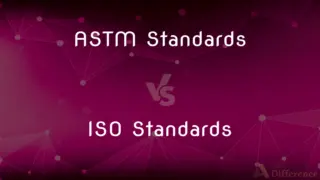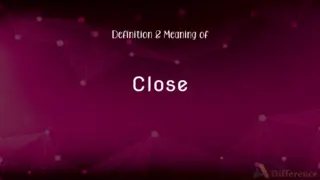CD-ROM vs. DVD — What's the Difference?
By Tayyaba Rehman — Published on January 22, 2024
CD-ROM (Compact Disc-Read Only Memory) is a pre-written, 700MB capacity disc, primarily for data storage; DVD (Digital Versatile Disc) holds up to 4.7GB, used for high-quality video and data storage.

Difference Between CD-ROM and DVD
Table of Contents
ADVERTISEMENT
Key Differences
CD-ROM, standing for Compact Disc-Read Only Memory, was introduced in the 1980s as a revolutionary data storage medium. It typically stores up to 700 megabytes of data. On the other hand, DVD, short for Digital Versatile Disc, emerged in the late 1990s, offering a significantly larger storage capacity, usually around 4.7 gigabytes. This major difference in storage capacity reflects the technological advancements from CD-ROM to DVD.
The physical dimensions of CD-ROM and DVD are identical, with both having a diameter of 120mm. However, the data storage technology differs significantly. CD-ROM uses a red laser at 780nm wavelength to read and write data, while DVD utilizes a shorter wavelength laser (650nm), which is more precise, allowing more data to be stored on the same size disc.
In terms of usage, CD-ROMs were primarily used for storing software, computer games, and music. DVDs, with their larger capacity, became popular for distributing full-length movies, large software applications, and high-quality audio. The DVD's enhanced storage capacity enabled it to store video in much higher resolution compared to CD-ROM.
Durability also varies between the two formats. While CD-ROMs are known for their longevity, they are susceptible to damage from scratches and exposure to light. DVDs have a similar risk but often come with better error correction and protective layers, making them slightly more durable.
Compatibility is another aspect where differences arise. Most modern DVD players and drives can read CD-ROMs, making DVDs more versatile. However, CD-ROM drives cannot read DVD discs due to the different laser technology and data encoding methods used.
ADVERTISEMENT
Comparison Chart
Storage Capacity
700MB
4.7GB
Laser Technology
780nm wavelength (Red Laser)
650nm wavelength (More precise)
Primary Use
Software, games, music
Movies, large software, high-quality audio
Durability
Susceptible to scratches and light damage
Better error correction, more durable
Compatibility
Can only be read by CD drives
Can be read by most DVD and CD drives
Compare with Definitions
CD-ROM
CD-ROM is a type of non-volatile optical data storage medium.
The software installation required a CD-ROM for setup.
DVD
DVD stands for Digital Versatile Disc, reflecting its diverse uses.
The software came on a DVD due to its large size.
CD-ROM
CD-ROM is a pre-recorded compact disc used mainly for distributing software.
My new computer game came on a CD-ROM.
DVD
DVDs are commonly used for high-quality video storage.
The complete TV series box set was available on DVD.
CD-ROM
CD-ROM technology revolutionized data sharing in the late 20th century.
We accessed our school projects from a CD-ROM.
DVD
DVD, an optical disc storage format, offers higher storage than CDs.
I bought a DVD of my favorite movie.
CD-ROM
CD-ROM, once a standard for PC games, holds about 700MB.
I used a CD-ROM to install my old graphic design software.
DVD
DVD is versatile, used for video, audio, and data storage.
Our family photos were saved on a DVD for safekeeping.
CD-ROM
CD-ROM is an older digital storage medium, read by a laser.
The encyclopedia set was available on CD-ROM.
DVD
DVD technology marked a significant leap in data storage and media quality.
I prefer watching movies on DVD for the enhanced quality.
CD-ROM
A compact disc that functions as read-only memory.
DVD
A high-density optical disc for storing large amounts of data, especially high-resolution audio-visual material.
CD-ROM
A compact disk that is used with a computer (rather than with an audio system); a large amount of digital information can be stored and accessed but it cannot be altered by the user.
DVD
A digital videodisc; a recording (as of a movie) on an optical disk that can be played on a computer or a television set
CD-ROM
A compact disk that is used with a computer (rather than with an audio system); a large amount of digital information can be stored and accessed but it cannot be altered by the user
Common Curiosities
What does CD-ROM stand for?
Compact Disc-Read Only Memory.
What is the storage capacity of a CD-ROM?
About 700 megabytes.
What was the primary use of CD-ROMs?
For distributing software, music, and computer games.
Are CD-ROMs still used today?
They're less common but still used for archival and legacy software.
What does DVD stand for?
Digital Versatile Disc.
Can DVDs store video in high definition?
Yes, DVDs are commonly used for high-quality video storage.
Can CD-ROMs be rewritten?
No, CD-ROMs are read-only and cannot be rewritten.
How much data can a DVD hold?
Standard DVDs hold about 4.7 gigabytes.
Are DVDs compatible with CD-ROM drives?
No, DVD discs require a DVD drive or player.
What are the advantages of DVDs over CD-ROMs?
Greater storage capacity and better video quality.
Can I play a CD-ROM on a DVD player?
Most DVD players can read CD-ROMs.
Are DVDs still popular?
While less common than before, they're still used for movies and data storage.
Can DVDs be rewritten?
Some DVDs are rewritable, like DVD-RW discs.
How do DVDs differ from Blu-rays?
Blu-rays have higher capacity and support higher video resolution.
What is the lifespan of a CD-ROM and DVD?
Both can last decades if stored properly, though DVDs often have better durability.
Share Your Discovery

Previous Comparison
Hallucinations vs. Illusions
Next Comparison
ASTM Standards vs. ISO StandardsAuthor Spotlight
Written by
Tayyaba RehmanTayyaba Rehman is a distinguished writer, currently serving as a primary contributor to askdifference.com. As a researcher in semantics and etymology, Tayyaba's passion for the complexity of languages and their distinctions has found a perfect home on the platform. Tayyaba delves into the intricacies of language, distinguishing between commonly confused words and phrases, thereby providing clarity for readers worldwide.














































